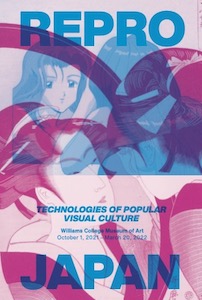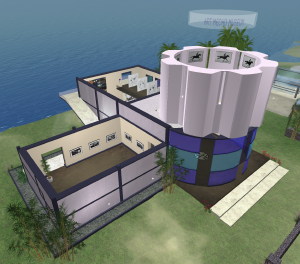I have done my share of writing and editing, but I am also interested in the possibility of producing literary theory and criticism in other media--for example visual or digital media. This page describes some related projects, several of them collaborations with visual artists or student designers.

Repro Japan: Technologies of Popular Visual Culture was an exhibition of Japanese popular media I curated at the Williams College Museum of Art. It ran from October 1, 2021 – March 19 2022.
The exhibition traced the links between Japanese popular culture and the technologies of mass reproduction that have created it, with more than a hundred artworks spanning three hundred years and a wide range of visual media. Starting with woodblock prints from eight different collections, the show moved forward through Edo-period textile design, 19th-century photography, manga, anime cels, and more. Fan art from around the world was represented by dōjinshi comics, cosplay costumes, Lolita fashion, and 3D printing. And a section on contemporary photography included work by Mariko Mori, Yasumasa Morimura, and Tomoko Sawada, among others. A very innovative gallery design by David Gürçay-Morris created a visual environment that allowed visitors to make connections across a web of different but related works.
WCMA's Lisa Dorin and I led a curatorial team that included Panalee Maskati, Eron Rauch, Diana Tolin, and Wei (Maggie) Wu.

The Repro Japan Exhibition described above ended in 2022, but you can still experience a 3D virtual walk-through built using Matterport. Using your web browser, you can navigate through the galleries, view the art, and pull up more detailed information about some of the objects. You can also see some new material developed especially for the model, including pop-up interviews with artists and curators. The model was coded by Beth Fischer at WCMA.

This, my current research project, involves making original comics and short animations to explain aspects of critical theory, with a focus on theories that have some spatial dimension or orientation of their own: structuralism, for example, or phenomenology.
The genesis for this project goes back to 2012, when I produced a short animated film to introduce concepts in structuralist and poststructuralist literary theory. (I created the script and storyboards for the video, and Galen Corey '14 did the animation.) This video, "Animating Poststructuralism," proved unexpectedly popular on YouTube with over 300,000 views. Since then digital animation has become easier, and I've also become more interested in manga and comics, so I've decided to tackle some new projects along these lines.
 I have done a couple of projects within the virtual online world of Second Life, which is something like a massively multi-player online "game" in which participants construct their own environments and devise their own rules.
I have done a couple of projects within the virtual online world of Second Life, which is something like a massively multi-player online "game" in which participants construct their own environments and devise their own rules.
The first project was an art museum within Second Life, conceived as a laboratory for thinking about issues involved in reading and critiquing animation, particularly Japanese anime and manga. I built the museum (pictured at left) in collaboration with students and Instructional Technology staff at Williams College. The museum no longer exists inside Second Life, but I wrote a little bit about it in an article titled "Virtual Creation, Simulated Destruction, and Manufactured Memory at the Art Mecho Museum in Second Life" in Mechademia 4 (2009): 198-210.
The second project was a January-term class titled Virtual Realities, where the students' final project was to create an environment in Second Life to comment on the issues of virtuality and simulation treated in the course. The result was a multi-storey funhouse, conceived by Lorraine Schmidt '13 and with levels designed by several different teams of students. Each level forced the user to navigate and comprehend a different kind of virtuality before s/he could advance to the next level. In parallel with this, science fiction author and Williams faculty member Paul Park taught students to write virtual reality fiction. Acting as representatives of these two virtual worlds--the textual and the digital--Paul and I tried to encourage students to think about how to fuse or distinguish these two realities. For a description of this course, see the Courses Page of this site.
 Mechademia is a series of volumes for scholarship on Japanese popular visual culture (described in more detail on the books page of this site). I was on the editorial board for the first arc of the series (2006-2015), when each volume had a few pieces in visual formats. I co-authored or edited several of these, including an editorial manifesto in manga form co-written with Frenchy Lunning and illustrated by Sara Pocock, an introduction to the manga of Komatsu Sakyō by Tatsumi Takayuki (detail at left), and a cosplay photography image spread co-authored with Eron Rauch.
Mechademia is a series of volumes for scholarship on Japanese popular visual culture (described in more detail on the books page of this site). I was on the editorial board for the first arc of the series (2006-2015), when each volume had a few pieces in visual formats. I co-authored or edited several of these, including an editorial manifesto in manga form co-written with Frenchy Lunning and illustrated by Sara Pocock, an introduction to the manga of Komatsu Sakyō by Tatsumi Takayuki (detail at left), and a cosplay photography image spread co-authored with Eron Rauch.
 I have been building web pages related to my academic work since the web's early days. I'm interested in visual design and layout, but also have a slightly obsessive preoccupation with the underlying HTML code--how it represents information, and how it relates to what you finally see in your browser. In the late 1990s and early 2000s I designed, redesigned, and/or coded sites for my departments at Stanford, UC Riverside, and Williams, as well as for my own courses. Today colleges have switched over to sites that are generated automatically from common templates, using software like Wordpress or Canvas. These systems have some advantages: I'm glad I no longer have to code each of my course pages by hand, for example. But I do miss the days when more faculty had an interest in the languages that underlay these pages, and when departments could build unique pages to reflect their own ideas about visual language and communication.
I have been building web pages related to my academic work since the web's early days. I'm interested in visual design and layout, but also have a slightly obsessive preoccupation with the underlying HTML code--how it represents information, and how it relates to what you finally see in your browser. In the late 1990s and early 2000s I designed, redesigned, and/or coded sites for my departments at Stanford, UC Riverside, and Williams, as well as for my own courses. Today colleges have switched over to sites that are generated automatically from common templates, using software like Wordpress or Canvas. These systems have some advantages: I'm glad I no longer have to code each of my course pages by hand, for example. But I do miss the days when more faculty had an interest in the languages that underlay these pages, and when departments could build unique pages to reflect their own ideas about visual language and communication.
These days my web development efforts are focused on this site, particularly Japanese for Your Mac, a reference for students and other beginners wanting to use Japanese with a Mac computer. If my server logs are to be believed, it gets over two thousand visitors each month. Most recently I designed and built a site for my latest book at intepretinganime.org.